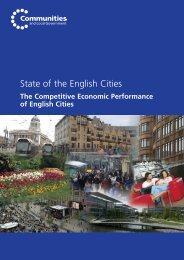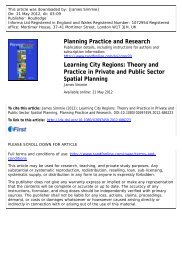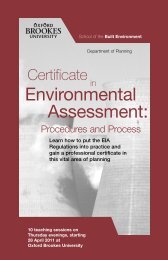History Matters: Path dependence and innovation in British city ...
History Matters: Path dependence and innovation in British city ...
History Matters: Path dependence and innovation in British city ...
You also want an ePaper? Increase the reach of your titles
YUMPU automatically turns print PDFs into web optimized ePapers that Google loves.
Table 8: Shift share analysis<br />
Indicator<br />
Time series<br />
Data source<br />
Geographic basis<br />
Def<strong>in</strong>itions<br />
Shift share analysis, based on employment change <strong>in</strong> 2-digit sectors (1992 SIC).<br />
1974, 1981, 1991, 2005 (economic trough years).<br />
ONS: 1974 & 1981 Census of Employment; 1991 Annual Employment Survey; 2005 Annual<br />
Bus<strong>in</strong>ess Inquiry.<br />
Data for 1991 & 2005 is for 1998 TTWAs; data for 1974 & 1981 is for 1984 TTWAs.<br />
Shift share analysis is a technique used to identify the relative contributions of <strong>in</strong>dustry<br />
structure or mix versus other non-structural factors to overall employment change <strong>in</strong> a <strong>city</strong>region.<br />
The analysis identifies two pr<strong>in</strong>cipal measures:<br />
1) Structural shift – this measures the structural <strong>in</strong>fluence on employment change, <strong>and</strong><br />
reflects the mix of <strong>in</strong>dustries <strong>in</strong> the <strong>city</strong>-region.<br />
2) Differential shift (also referred to as the regional or competitive shift) – this measures the<br />
contribution to overall employment change due to each <strong>in</strong>dustry <strong>in</strong> the <strong>city</strong>-region grow<strong>in</strong>g at<br />
a faster or slower rate than its national growth rate. It removes structural effects, <strong>and</strong> allows<br />
exam<strong>in</strong>ation of a residual element which <strong>in</strong>cludes non-structural <strong>in</strong>fluences such as policy.<br />
The differential shift provides a measure of the effect of the <strong>city</strong>-region’s competitiveness on<br />
employment change.<br />
Comments<br />
There are some temporal <strong>and</strong> geographic discont<strong>in</strong>uities <strong>in</strong> the underly<strong>in</strong>g employment data<br />
series, due to changes <strong>in</strong> <strong>in</strong>dustrial classifications <strong>and</strong> TTWA def<strong>in</strong>itions. This means that it is<br />
not possible to carry out shift share analysis over the full 1974-2005 period; results for the<br />
shorter 1991-2005 period are not affected by these problems.<br />
Table 9: Population<br />
Indicator<br />
Time series<br />
Data source<br />
Geographic basis<br />
Def<strong>in</strong>itions<br />
Comments<br />
Resident population <strong>in</strong> <strong>city</strong>-region.<br />
1981 to 2006 (annual).<br />
ONS, mid-year population estimates.<br />
Data for local authority districts is best fit to 1998 TTWA boundaries.<br />
None.<br />
None.<br />
Table 10: Employment change<br />
Indicator<br />
Time series<br />
Data source<br />
Geographic basis<br />
Def<strong>in</strong>itions<br />
Comments<br />
Number of employees <strong>in</strong> employment.<br />
1981, 1991 & 2005 (economic trough years).<br />
ONS: 1981 Census of Employment; 1991 Annual Employment Survey; 2005 Annual Bus<strong>in</strong>ess<br />
Inquiry.<br />
Data for local authority districts is best-fit to 1998 TTWA boundaries (pre-1996 districts are<br />
used for 1981 data).<br />
None.<br />
Persons work<strong>in</strong>g on a self-employed basis are excluded from the figures.<br />
83













